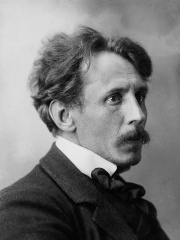
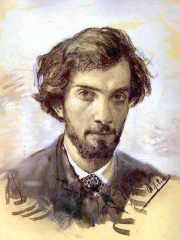
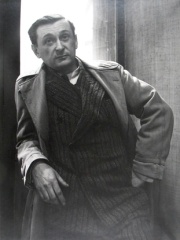
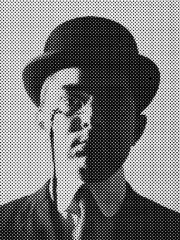
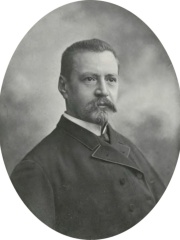
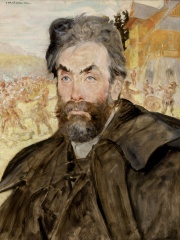
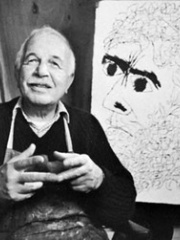
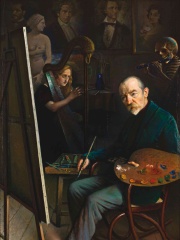
The Most Famous
PAINTERS from Lithuania
Top 9
The following people are considered by Pantheon to be the most legendary Lithuanian Painters of all time. This list of famous Lithuanian Painters is sorted by HPI (Historical Popularity Index), a metric that aggregates information on a biography's online popularity.

1. Mikalojus Konstantinas Čiurlionis (1875 - 1911)
With an HPI of 70.35, Mikalojus Konstantinas Čiurlionis is the most famous Lithuanian Painter. His biography has been translated into 43 different languages on wikipedia.
Mikalojus Konstantinas Čiurlionis (Polish: Mikołaj Konstanty Czurlanis; 22 September [O.S. 10 September] 1875 – 10 April [O.S. 28 March] 1911) was a Lithuanian composer, painter, choirmaster, cultural figure, and writer in Polish. Čiurlionis contributed to symbolism and Art Nouveau, and was representative of the fin de siècle epoch. He has been considered one of the pioneers of abstract art in Europe. During his short life, he composed about 400 pieces of music and created about 300 paintings, as well as many literary works and poems. The majority of his paintings are housed in the M. K. Čiurlionis National Art Museum in Kaunas, Lithuania. His works have had a profound influence on modern Lithuanian culture.

2. Isaac Levitan (1860 - 1900)
With an HPI of 65.82, Isaac Levitan is the 2nd most famous Lithuanian Painter. His biography has been translated into 49 different languages.
Isaac Ilyich Levitan (Russian: Исаа́к Ильи́ч Левита́н; 30 August [O.S. 18 August] 1860 – 4 August [O.S. 22 July] 1900) was a Russian landscape painter who advanced the genre of the "mood landscape".

3. Jacques Lipchitz (1891 - 1973)
With an HPI of 65.00, Jacques Lipchitz is the 3rd most famous Lithuanian Painter. His biography has been translated into 27 different languages.
Jacques Lipchitz (22 August [O.S. 10 August] 1891 – 26 May 1973) was a Lithuanian-born French-American Cubist sculptor. Lipchitz retained highly figurative and legible components in his work leading up to 1915–16, after which naturalist and descriptive elements were muted, dominated by a synthetic style of Crystal Cubism. In 1920 Lipchitz held his first solo exhibition, at Léonce Rosenberg's Galerie L'Effort Moderne in Paris where he was counted as part of the School of Paris. Fleeing the Nazis he moved to the US and settled in New York City and eventually Hastings-on-Hudson. While in the US, he created a number of his best-known works, including the outdoor sculptures The Song of the Vowels, Birth of the Muses, and Bellerophon Taming Pegasus, the last of which was completed after his death.

4. George Maciunas (1931 - 1978)
With an HPI of 60.99, George Maciunas is the 4th most famous Lithuanian Painter. His biography has been translated into 18 different languages.
George Maciunas (English: ; Lithuanian: Jurgis Mačiūnas; November 8, 1931 Kaunas – May 9, 1978 Boston, Massachusetts) was a Lithuanian American artist, art historian, and art organizer who was the founding member and central coordinator of Fluxus, an international community of artists, architects, composers, and designers. He is most famous for organizing and performing in early Fluxus Happenings and Festivals, for his Fluxus graphic art work, and for assembling a series of highly influential Fluxus artists' multiples.
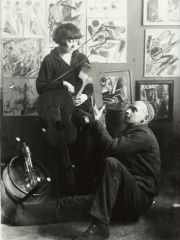
5. Varvara Stepanova (1894 - 1958)
With an HPI of 60.75, Varvara Stepanova is the 5th most famous Lithuanian Painter. Her biography has been translated into 20 different languages.
Varvara Fyodorovna Stepanova (Russian: Варва́ра Фёдоровна Степа́нова; 3 November [O.S. 22 October] 1894 – 20 May 1958) was a Russian artist. With her husband Alexander Rodchenko, she was associated with the Constructivist branch of the Russian avant-garde, which rejected aesthetic values in favour of revolutionary ones. Her activities extended into propaganda, poetry, stage scenery and textile designs.

6. Michał Elwiro Andriolli (1836 - 1893)
With an HPI of 57.80, Michał Elwiro Andriolli is the 6th most famous Lithuanian Painter. His biography has been translated into 17 different languages.
Michał Elwiro Andriolli (Lithuanian: Mykolas Elvyras Andriolis, Italian: Elviro Michele Andriolli; 2 November 1836, in Vilnius – 23 August 1893, in Nałęczów) was a Polish illustrator, painter and architect of Italian descent. He is notable for his illustrations to Mickiewicz's Pan Tadeusz, as well as a distinctive style of villas built outside Warsaw. He was probably most well known for his architecture – Świdermajer. This was a regional architectural style common in the Otwock, Poland region. These structures were wooden in construction and were popularized from the turn of the 19th and 20th centuries. Its creator was Michał Elwiro Andriolli. It is characterized by gazebos and decorations above the windows, some of the houses also had turrets. Pine trees were planted together with the buildings as part of the composition.

7. Stanisław Witkiewicz (1851 - 1915)
With an HPI of 57.54, Stanisław Witkiewicz is the 7th most famous Lithuanian Painter. His biography has been translated into 21 different languages.
Stanisław Witkiewicz (Lithuanian: Stanislovas Vitkevičius; 8 May 1851 – 5 September 1915) was a Polish painter, art theoretician, and amateur architect, known for his creation of "Zakopane Style".

8. Ben Shahn (1898 - 1969)
With an HPI of 56.36, Ben Shahn is the 8th most famous Lithuanian Painter. His biography has been translated into 20 different languages.
Ben Shahn (September 12, 1898 – March 14, 1969) was an American artist. He is best known for his works of social realism, his left-wing political views, and his series of lectures published as The Shape of Content. Born Benjamin Shahn in what was then the Russian Empire, in 1898, he emigrated with his Jewish family to the United States in 1906 following his father’s exile to Siberia for suspected revolutionary activity. Settling in Brooklyn, Shahn initially trained as a lithographer. After briefly studying biology at New York University, he turned fully to art, attending the National Academy of Design and traveling through Europe with his first wife. Though influenced by European modernists, Shahn ultimately rejected their stylistic approaches in favor of a realist mode aligned with his social concerns, a direction crystallized by his 1932 series The Passion of Sacco and Vanzetti, which responded critically to contemporary politics. During the Great Depression, Shahn’s work with the Public Works of Art Project, the Resettlement Administration, and the Farm Security Administration further solidified his role as a social-documentary artist. Collaborating with figures such as Diego Rivera and Walker Evans, he produced photographic and mural work addressing labor conditions and American life under the New Deal. His murals for the Jersey Homesteads school, the Bronx Post Office, and the Social Security Administration exemplify themes such as immigrant hardship, labor struggles, and collective reform, often grounding his compositions in visual references to Jewish tradition and American political history. Later in his career, he contributed to wartime propaganda through the Office of War Information, although his anti-war stance emerged in later paintings like Death on the Beach and Liberation. He produced commercial illustrations for major magazines, created stained glass, and represented the United States at the 1954 Venice Biennale. Consistently rejecting abstraction in favor of legible, symbol-laden realism, Shahn's compositions often featured expressive distortions, asymmetry, and dynamic spatial arrangements. He received honorary doctorates from Princeton University and Harvard University, and joined Harvard as a Charles Eliot Norton professor in 1956.

9. Yehuda Pen (1854 - 1937)
With an HPI of 55.79, Yehuda Pen is the 9th most famous Lithuanian Painter. His biography has been translated into 17 different languages.
Yudel Pen, also known as Yehuda Pen or Yury Pen, (5 June [24 May Old Style] 1854 - 28 February 1937) was a Jewish artist and art teacher active in the Russian Empire and Soviet Union. He is best known for founding an influential art school in Vitebsk and teaching notable avant-garde artists like Marc Chagall, El Lissitzky, and Ossip Zadkine. Pen was one of the first painters to consistently depict Jewish life in the Pale of Settlement; he is sometimes called "the Sholem Aleichem of painting". Born in a poor Jewish family in a shtetl, he showed an early talent for drawing and painting. He got an academic training in the St. Petersburg Academy of Arts, and several years after graduation he opened an art school in Vitebsk, where he taught many poor, mainly Jewish children, often for free. Pen was murdered in 1937; though officially called a robbery, his students believed that he was killed by NKVD during the Stalin's purges. A lot of his paintings were lost during the World War II. The surviving works are split between the National Art Museum in Minsk and the Vitebsk Regional Museum of Local History.
People
Pantheon has 9 people classified as Lithuanian painters born between 1836 and 1931. Of these 9, none of them are still alive today. The most famous deceased Lithuanian painters include Mikalojus Konstantinas Čiurlionis, Isaac Levitan, and Jacques Lipchitz.
Deceased Lithuanian Painters
Go to all RankingsMikalojus Konstantinas Čiurlionis
1875 - 1911
HPI: 70.35
Isaac Levitan
1860 - 1900
HPI: 65.82
Jacques Lipchitz
1891 - 1973
HPI: 65.00
George Maciunas
1931 - 1978
HPI: 60.99
Varvara Stepanova
1894 - 1958
HPI: 60.75
Michał Elwiro Andriolli
1836 - 1893
HPI: 57.80
Stanisław Witkiewicz
1851 - 1915
HPI: 57.54
Ben Shahn
1898 - 1969
HPI: 56.36
Yehuda Pen
1854 - 1937
HPI: 55.79
Overlapping Lives
Which Painters were alive at the same time? This visualization shows the lifespans of the 9 most globally memorable Painters since 1700.

